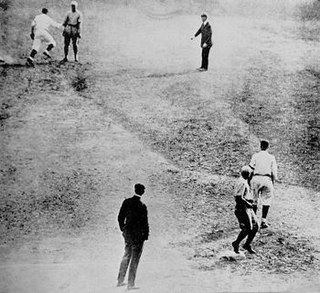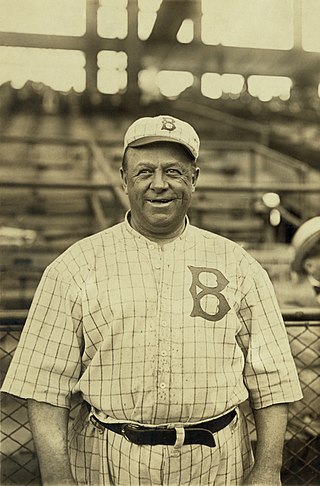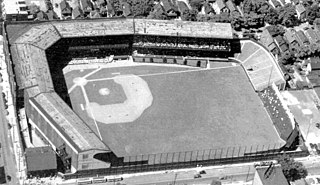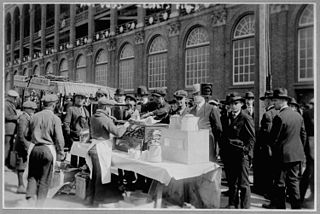
In baseball, an unassisted triple play occurs when a defensive player makes all three outs by himself in one continuous play, without his teammates making any assists. Neal Ball was the first to achieve this in Major League Baseball (MLB) under modern rules, doing so on July 19, 1909. For this rare play to be possible there must be no outs in the inning and at least two runners on base, normally with the runners going on the pitch. An unassisted triple play usually consists of a hard line drive hit directly at an infielder for the first out, with that same fielder then able to double off one of the base runners and tag a second for the second and third outs.

Stanley Anthony Coveleski was an American right-handed pitcher in Major League Baseball who played for four American League (AL) teams between 1912 and 1928, primarily the Cleveland Indians. The star of the Indians pitching staff, he won over 20 games each year from the war-shortened 1918 season through 1921, leading the AL in shutouts twice and in strikeouts and earned run average (ERA) once each during his nine years with the club. The star of the 1920 World Series, he led the Indians to their first title with three complete-game victories, including a 3–0 shutout in the Game 7 finale. Traded to the Washington Senators after the 1924 season, he helped that club to its second AL pennant in a row with 20 victories against only 5 losses, including a 13-game winning streak, while again leading the league in ERA.

Stephen Francis O'Neill was an American professional baseball catcher and manager. He played his first 13 seasons with the Cleveland Indians. As a manager, he led the 1945 Detroit Tigers to a World Series championship.

Wilbert Robinson, nicknamed "Uncle Robbie", was an American catcher, coach and manager in Major League Baseball (MLB). He played in MLB for the Philadelphia Athletics, Baltimore Orioles, and St. Louis Cardinals. He managed the Orioles and Brooklyn Robins. Robinson was inducted into the Baseball Hall of Fame in 1945.

League Park was a baseball park located in Cleveland, Ohio, United States. It was situated at the northeast corner of Dunham Street and Lexington Avenue in the Hough neighborhood. It was built in 1891 as a wood structure and rebuilt using concrete and steel in 1910. The park was home to a number of professional sports teams, most notably the Cleveland Indians of Major League Baseball. League Park was first home to the Cleveland Spiders of the National League from 1891 to 1899 and of the Cleveland Lake Shores of the Western League, the minor league predecessor to the Indians, in 1900. From 1914 to 1915, League Park also hosted the Cleveland Spiders of the minor league American Association. In the late 1940s, the park was also the home field of the Cleveland Buckeyes of the Negro American League.

The 1925 World Series was the championship series of the 1925 Major League Baseball season. A best-of-seven playoff, it was played between the National League (NL) pennant winner Pittsburgh Pirates and the Washington Senators. The Pirates defeated the Senators four games to three to win the series.
The 1930 World Series featured the defending World Series champion Philadelphia Athletics against the National League (NL) champion St. Louis Cardinals. The Athletics defeated the Cardinals in six games, 4–2. Philadelphia's pitching ace Lefty Grove, and George Earnshaw, the No. 2 man in Mack's rotation, won two games apiece. Earnshaw also pitched seven scoreless innings as Game 5 starter, but ended up with a no-decision as Grove relieved him in the eighth and took the win on Jimmie Foxx's two-run homer in the top of the ninth for the game's only scoring.
The 1948 World Series was the championship series in Major League Baseball for the 1948 season. The 45th edition of the World Series, it matched the American League (AL) champion Cleveland Indians and the National League (NL) champion Boston Braves. The Braves had won the National League pennant for the first time since the "Miracle Braves" team of 1914, while the Indians had spoiled a chance for the only all-Boston World Series by winning a one-game playoff against the Boston Red Sox for the American League flag. Though superstar pitcher Bob Feller failed to win either of his two starts, the Indians won the Series in six games to capture their second championship and their first since 1920.

Michael Robert "Mickey" Morandini, is an American former professional baseball second baseman and coach, who played in Major League Baseball (MLB) for the Philadelphia Phillies, Chicago Cubs, and Toronto Blue Jays. His career highlights include selection as a 1995 National League (NL) All-Star, playing for the Phillies in the 1993 NL Championship Series and World Series, and appearing for the Cubs in the 1998 NL Division Series.

James Charles Jacob Bagby Sr. was an American right-handed starting pitcher in Major League Baseball. Bagby was the first pitcher to hit a home run in a modern World Series, and one of the last pitchers to win over 30 games in one season.

George Henry Burns, nicknamed "Tioga George", was an American first baseman in Major League Baseball (MLB) who played for five American League (AL) teams from 1914 to 1929.
The following are the baseball events of the year 1954 throughout the world.

William Adolf Wambsganss was an American second baseman in Major League Baseball. From 1914 through 1926, Wambsganss played for the Cleveland Indians, Boston Red Sox, and Philadelphia Athletics. He is best remembered for making one of the most spectacular defensive plays in World Series history, an unassisted triple play.
The following are the baseball events of the year 1930 throughout the world.

The following are the baseball events of the year 1920 throughout the world.

Clarence Elmer Mitchell was an American Major League Baseball pitcher.

Lowell Otto Miller was an American catcher in Major League Baseball from 1910 through 1922 for Brooklyn teams the Superbas, Dodgers (1911–1912) and Robins (1914–1922). Nicknamed "Moonie", Miller batted and threw right-handed, and was listed at 6 feet 0 inches (1.83 m) and 196 pounds (89 kg).
The 1920 Cleveland Indians season was the 20th season in franchise history. The Indians won the American League pennant and proceeded to win their first World Series title in the history of the franchise. Pitchers Jim Bagby, Stan Coveleski and Ray Caldwell combined to win 75 games. Despite the team's success, the season was perhaps more indelibly marked by the death of starting shortstop Ray Chapman, who died after being hit by a pitch on August 16.
The 1920 Brooklyn Robins, also known as the Dodgers, won 16 of their final 18 games to pull away from a tight pennant race and earn a trip to their second World Series against the Cleveland Indians. They lost the series in seven games.

Peter John Kilduff was an American professional baseball player who played second base from 1917 to 1921, with the Giants, Cubs, and Brooklyn Robbins, and as a player / manager in the minors for several years after. Starting 2B for the pennant winning 1920 Brooklyn Robbins, hitting .272/.351/.360 with good defense, good for 3.4 fWAR at the age of 27. He appeared in the 1920 World Series with the Brooklyn Robins where he was one of three outs in Bill Wambsganss's unassisted triple play. Still currently the only unassisted triple play ever in post season play. He was again a solid contributor in 1921 at the age of 28 but was optioned down to the minors for the 1922 season.

















